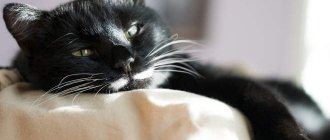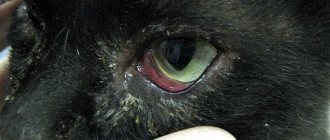4090Pavel
In most cats and cats, bilateral inflammation develops, which is not localized, but covers the entire thoracic region. Lack of timely monitoring can lead to death. With pleurisy, the pulmonary region and heart are at risk, and these are vital systems of the pet’s body.
In case of illness, the pleural surface is filled with moisture. In a normal healthy state, the pleura in the chest also releases moisture, but this amount is enough for “basic” processes to occur. When the fluid volume is exceeded, the pressure on the organs increases. If treatment is not organized, pathologies with the lungs and heart cannot be avoided.
© shutterstock
Why does pathology develop?
The pleural cavity can become inflamed under the influence of the following factors:
- heart failure, which is complicated by tumors;
- lack of protein in the body;
- impaired vascular permeability;
- disruptions in the lymphatic ducts;
- progressive accumulation of chyle in the pleural cavity, flowing from the thoracic duct;
- diaphragmatic hernia.
In addition, pneumonia can be caused by a viral, fungal or bacterial type of illness.
Classification of the disease
Depending on the origin, pleurisy in cats is divided into 2 types:
The disease may be a consequence of a metastatic tumor of another organ in the animal.
- Primary. The serous membrane appears directly in the affected area.
- Secondary. It develops under the influence of other ailments that are localized in neighboring internal organs and spread to the pleura. We are talking about cancers that metastasize, as well as other diseases of the respiratory system.
Pleurisy that affects cats is classified based on the course of the disease:
- chronic;
- spicy;
- subacute
According to localization, pathology is divided as follows:
- Local. The inflammatory process is localized in one place.
- Diffuse. Inflammation is scattered throughout the serous membrane.
- One-sided. The left or right side of the sternum is affected.
- Double sided. The inflammatory process is localized on both sides at once.
Classification according to the nature of the course:
With this disease, effusion may form.
- Exudative. Purulent effusion is released into the pleural cavity.
- Dry. The exudate consists of protein fibrinogen and does not settle on the serous membranes, due to which effusion fluids do not accumulate in the pleural cavity.
The disease is also divided according to the degree of the inflammatory process:
- serous;
- serous-fibrous;
- fibrous;
- hemorrhagic;
- ichorous;
- purulent.
Introduction
Reasons for increasing the rate of pleural fluid formation:
- increased hydrostatic pressure in the blood vessels (heart failure, cardiac tamponade, vascular obstruction);
- decreased oncotic pressure (decreased albumin in enteropathies, hepatopathy, chronic bleeding in the gastrointestinal tract);
- increased vascular porosity (vasculitis, systemic inflammation, pancreatitis, infections, allergic reactions, tumors);
- negative pressure in the pleural cavity (after surgical interventions, with pleural fibrosis).
Reasons for reducing the rate of absorption of pleural fluid:
- increased pressure in the lymphatic vessels (increased pressure in the right atrium, arteriovenous fistulas, obstruction of the lymphatic vessels);
- decreased pleural permeability (fibrosis).
The leakage of fluid can occur from a damaged blood vessel, from a tumor, or from a damaged lymphatic vessel.
Pleural effusion is not a disease, but a syndrome that can manifest itself in various diseases for various reasons, and several reasons can be combined.
Respiratory failure can be assessed by the frequency of respiratory movements at rest in 1 minute (less than 24 is normal, and more than 27 is respiratory failure). These indicators can be used by pet owners to monitor changes in their pet's condition during treatment.
Respiratory failure is an emergency! It is important to identify signs of respiratory distress as soon as possible when your cat arrives at the clinic.
It is best to prepare for the appearance of such a patient in advance, for example, after a telephone call from the cat’s owners or a warning from the clinic administrator about an emergency patient. All manipulations with such an animal must be performed without forgetting its extremely unstable condition! At any time, any action with a cat can provoke a deterioration in its condition and lead to death. Typical provoking factors: stuffy room, forced proximity to other animals, stress (when removing the animal from a carrier, seeing a doctor, during an examination), change in body position, painful manipulations.
Heart sounds and pulmonary sounds in the ventral chest are muffled. The limits of muting depend on the amount of fluid in the pleural cavities.
Percussion It is best if the cat is in a standing position. It is necessary to percussion in the area of several intercostal spaces, at several levels (from the spine to the sternum or vice versa) (Fig. 3). The presence of liquid muffles and dulls the percussion sound. Since the fluid occupies the underlying sections of the pleural cavities, it is often possible to determine the horizontal limit of sound muffling (essentially the fluid level). With unilateral accumulation of fluid, dullness of percussion sound is detected on the corresponding side.
Admission X-rays A cat with severe respiratory distress may die if attempted to be placed in a lateral or dorsal position. Therefore, in cases of severe respiratory failure and if free fluid is suspected in the pleural cavities (based on the results of examination, auscultation and percussion), many guidelines recommend taking radiography only after thoracentesis, aspiration of fluid and stabilization of the animal. Perhaps you should limit yourself to taking a picture in a position in which it is easier for the cat to breathe. If she is lying on her stomach, then, being careful not to frighten the animal and without forcing her into a position to obtain an ideal position, you should take a picture in a dorsoventral projection. The purpose of the image upon admission of the patient is to confirm the presence of free fluid in the pleural cavities. You can begin to look for other symptoms after the fluid has been aspirated and the cat begins to breathe normally.
A small amount of free fluid in the pleural cavities is manifested by filling of the interlobar notches of the lungs (photo 3). The locations of the interlobar notches depend on the position of the animal during radiography (Fig. 4).
There is a possibility that even after a well-performed aspiration of the fluid, the x-ray will show nothing but residual fluid and atelectatic areas of the lungs. However, it is often possible to detect signs of a tumor process in the mediastinum, ribs, lungs (photo 4). In addition to searching for pathological changes, radiography after thoracentesis is necessary for two more reasons: 1) to assess the residual amount of fluid (which can be useful in tracking the dynamics of fluid accumulation, photo 5); 2) to control the absence of free gas in the pleural cavities, which could appear there after thoracentesis. Radiographs taken at different positions in the horizontal beam can sometimes be useful because the liquid flows down and, when photographed in a horizontal beam, ceases to cover the higher areas of the lungs and mediastinum; however, unfortunately, not all X-ray machines allow taking such pictures. Masses in the mediastinum may be mistaken for free fluid in the pleural spaces (Figure 6).
Video 1. Flotation of a lung lobe in the presence of free fluid in the chest cavity. A cat with chylous contents in the chest cavity; the video clearly shows the movement of the lung lobe with impaired airiness.
Computed tomography This method in many cases allows us to identify the causes of the appearance of fluid. With CT (unlike radiography), the fluid present in the pleural cavities is not an obstacle to diagnosis. Using CT, you can visualize space-occupying formations of the lungs, pleura, and mediastinum. CT angiography makes it possible to examine the main and pulmonary vessels. This is necessary if pulmonary embolism, lobar volvulus, and obstruction of the cranial or caudal vena cava are suspected (photo 13, video 2). CT lymphography allows you to examine the thoracic lymphatic duct. During a CT examination, a biopsy of objects of interest can be performed with step-by-step needle insertion and CT control of its position.
Video 2. CT angiography of a cat with chylothorax.
Thoracoscopy and thoracotomy It is carried out more often for therapeutic purposes or for diagnostic purposes - if it is necessary to take material for histological examination under visual control (pleura, part of the lung) or for revision of the pleural cavities, if other methods have not made it possible to make a diagnosis.
Pleurisy in cats is an inflammatory process located on the serous membrane (pleura), which covers the lungs and other organs of the animal’s chest. There are two types of pleura: visceral and parietal. The first is located on the pet’s lungs, and the second lines the chest from the inside, covering the diaphragm and mediastinum. In the gap between these two serous membranes there is a pleural cavity, the main essence of which is the presence of a special fluid that acts as a lubricant that softens the friction of the lungs during movement.
The danger of pleurisy is that the focus of the disease not only develops on one of the most important organs of the pet’s body, but is also located in close proximity to the heart. Regardless of the type of disease, it has an extremely negative impact on the well-being of your furry friend. Pleurisy that is not detected in time can lead to a fatal outcome in a cat in a fairly short time. The article will discuss what types of pathology there are, its signs and symptoms will be listed, and methods of treating pleurisy will also be discussed.
What symptoms indicate the disease?
In cats, pleural disease causes the following symptoms:
In this state, the animal assumes a forced sitting position with its head extended.
- difficulty breathing;
- sitting position with head extended;
- change in the shade of the mucous membranes to blue;
- breathing not through the nose, but through the mouth;
- loss of appetite;
- weakness;
- apathy.
Symptoms of hydrothorax: how to recognize the disease in your pet?
The first thing you need to pay attention to is your pet’s behavior. With hydrothorax, shortness of breath gradually develops, the body temperature remains normal, but due to internal changes, the mucous membranes become bluish (cyanosis). When palpating the chest area, there is no pain, but there is swelling.
One of the features of hydrothorax is its stages. Periods of exacerbation may be followed by temporary relief. However, don’t mistake this for recovery! Remember that hydrothorax in cats requires professional veterinary treatment.
Signs of hydrothorax (dropsy) in cats:
- general weakness,
- fast fatiguability,
- increasing shortness of breath,
- appetite disorders,
- cyanosis of the mucous membranes (pressure restores the natural color),
- swelling in the perineum, chest, eye area and paws.
A cat suffering from dropsy loses the desire to play. She spends more time in solitude, has virtually no contact with people, and does not go into arms. With hydrothorax, animals lie down with their paws widely spread forward and their heads stretched upward. Breathing becomes heavier (long inhalation and short exhalation).
Diagnostic measures
If owners suspect that pulmonary pleurisy has occurred in cats, it is important to contact a medical facility as quickly as possible. At the appointment, the doctor will conduct a survey of the animal’s owners, during which he will find out how long ago the unwanted symptoms began. Then the veterinarian begins tapping and listening to the chest. To confirm the preliminary diagnosis, the pet is sent for the following examinations:
- ultrasound examination, which allows you to determine whether there is fluid in the chest cavity;
- X-ray of the sternum;
- general and biochemical blood tests;
- puncture of the chest followed by sending the resulting effusion to the laboratory.
Main causes of thoracic hydrops
Hydrothorax in cats develops due to the accumulation of edematous fluid (transudate) in the pleural zone. This is caused by the high permeability of the pleura, as well as lymphatic and blood vessels. Transudate “leaks” between the pleural layers, provoking the development of thoracic hydrops and the appearance of the main symptoms of the disease.
Causes of hydrothorax in cats:
- Infectious diseases.
Pathogenic microorganisms disrupt the permeability of the pleura and capillaries, which leads to the development of thoracic hydrops. Among the infectious diseases that can lead to hydrothorax: actinomycosis, nocardiosis, panleukopenia, etc.
- Mechanical damage to the chest.
Severe trauma (such as a fall from a great height onto the chest area) can result in serous fluid effusion in cats. As a result of mechanical compression, not only blood vessels are damaged, but also lymphatic vessels.
- Violations of internal organs.
Diseases of the cardiovascular system, liver, kidneys or respiratory organs can cause thoracic hydrops in cats. For example, congestive processes in the heart muscle lead to intense effusion of edematous fluid into the chest.
- Helminthic diseases.
Compression of blood vessels in the liver during echinococcosis (a chronic parasitic disease) often causes chest dropsy. The only way to avoid this is to promptly carry out antiparasitic treatment in a veterinary clinic.
- Oncological pathologies.
Tumors located in the respiratory or digestive system lead to hydrothorax. Enlarged lymph nodes, metastases, compression of the lymphatic duct - all this leads to the effusion of edematous fluid into the chest.
Hydrothorax can be caused not only by these, but also by other reasons (blood clotting disorders, damage to blood vessels, low levels of protein in the blood, etc.). Only a specialist can determine the exact cause that provoked the development of thoracic hydrops. If you suspect that your cat has hydrothorax, do not hesitate - contact a veterinary clinic in Moscow.
Treatment of pathology
To alleviate the condition, the pet needs a thoracentesis.
If pleurisy is diagnosed in a pet, it is important to start treatment as quickly as possible, since the undesirable symptoms characteristic of this disease lead to respiratory failure. In the absence of appropriate treatment, death cannot be ruled out. Veterinarian Maria Aleksandrovna Voitekha notes that therapeutic measures begin with the elimination of excess moisture. For these purposes, thoracentesis is performed, which is a procedure for puncturing the chest wall to enter the pleural cavity. Before the procedure, the animal is usually given local anesthesia.
After this procedure, they resort to surgical intervention, which is considered the most effective and safe method of treating pleurisy. This is the only way out that will prevent complications and death. Postoperative treatment includes the prescription of antibacterial medications, which make it possible to avoid infection. Antimicrobial medications are also prescribed. Often medications are given orally, however, if the cat's condition is severe, pharmaceuticals may also be prescribed intravenously. Therapy is completed with medications that improve the functioning of the cardiovascular system.
Symptoms
What are the symptoms of this disease? Let us list the most typical ones, allowing us to more or less accurately make at least a preliminary diagnosis:
- Difficulty, or sharply rapid, shallow breathing.
- The cat takes a sitting position and stretches its head up. A very specific symptom, indicating the accumulation of a large amount of exudate. It is important to remember that in a different position the animal simply cannot breathe.
- Cyanosis (blue discoloration of all visible mucous membranes).
- The cat begins to breathe through its mouth.
- Lethargy, apathetic state.
Prognosis for recovery
If the owner does not closely monitor the behavior and changes in the condition of the pet, pleurisy will cause the death of the pet. The disease cannot go away on its own. The fluid that accumulates increases the pressure to critical levels, as a result of which the cat experiences cardiac or respiratory arrest. Therapy is selected individually for each specific animal. This also applies to the duration of treatment. It is important that interrupting the course is strictly prohibited, since the likelihood of a relapse increases, which the pet may not survive.
If the prognosis is favorable, the pet’s therapy will last at least a month.
When the disease is diagnosed at an early stage, doctors make a favorable prognosis. In this situation, therapy takes about 1 month. If we are talking about the chronic stage of pleurisy, treatment can take a lifetime. In this case, the prognosis is not always favorable. Owners will need to constantly give the animal the required medications prescribed by the veterinarian, as well as normalize the cat’s diet. It is recommended to exclude fatty foods, spicy and sweet foods. Fermented milk products, fish, chicken and pork will be useful for a sick animal. However, these foods should be given in limited quantities.
Treatment of thoracic hydrops in cats
Treatment of hydrothorax in cats is based on an integrated approach. It is necessary to eliminate the cause of the disease, as well as its symptoms. The cat needs to be provided with complete peace and comfortable conditions. It is necessary to completely exclude liquid food from the diet and reduce the consumption of water, milk and other liquids.
You need to feed your pet often, but in small portions. The diet should be balanced; if necessary, the veterinarian will give dietary recommendations.
If chest dropsy is caused by an infectious disease, then treatment is aimed at combating its causative agent. If a parasitic infection is detected, deworming is carried out in the clinic against parasites. If the disease was provoked by cachexia (depletion of the body), then a therapeutic diet, vitamin intake and supportive therapy are provided.
At the same time, symptomatic treatment is prescribed. The first thing the veterinarian does is remove the accumulated edematous fluid (transudate) using a puncture of the pleural cavity. Then, to restore the function of the heart muscle and reduce the load on it, heart medications are prescribed.
At the discretion of the doctor, maintenance therapy may include not only diet and vitamin therapy, but also infusion therapy. The dropper contains glucose and a calcium chloride solution. They ensure rapid recovery of the body of an animal exhausted due to a serious illness. Additionally, diuretics are prescribed.
Preventive actions
To prevent pleurisy from occurring in a cat, owners will need to carefully monitor their pet. It is important to protect him from hypothermia and not let him go outside during the cold season. It is not recommended to bathe a cat in winter, especially if there is no heating in the room. It is important to prevent injury to your pet and monitor its diet. The menu should include food containing sufficient amounts of microelements and vitamins. They are found in fish, boiled potatoes, and legumes.
Veterinarians specify that the cat can get the components from vitamin-mineral complexes, which are presented in a wide range in pharmacy chains. Before using medications, you should consult a veterinarian. It is important to treat any diseases, especially the respiratory tract, as they are often responsible for the development of pleurisy. Pet owners should visit a veterinary clinic at least once every six months for a routine examination of their cat.











